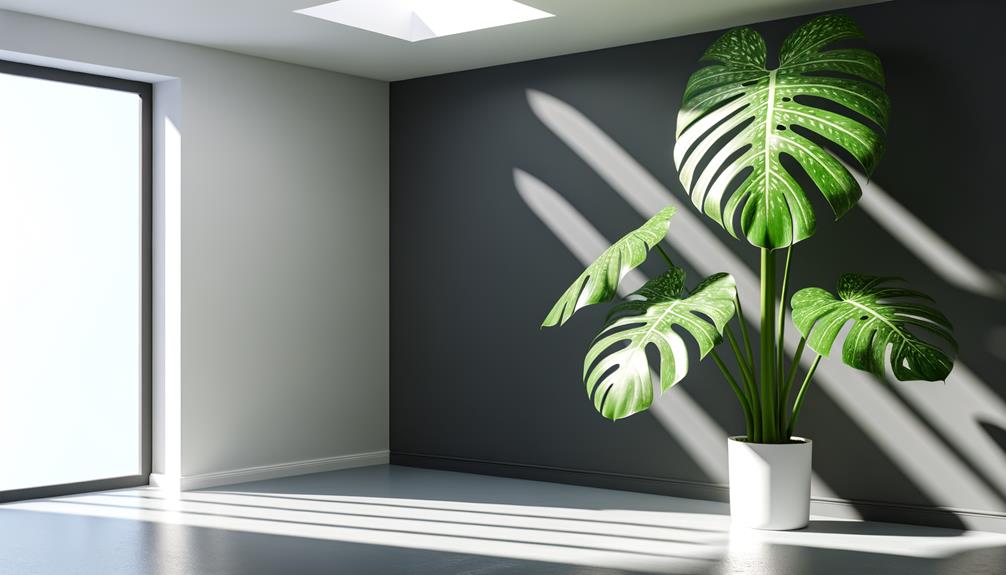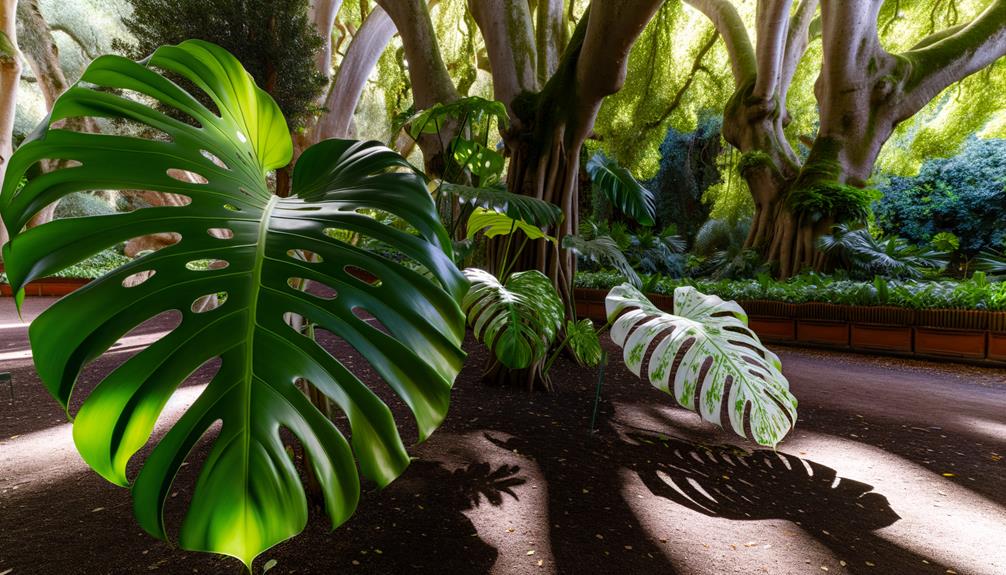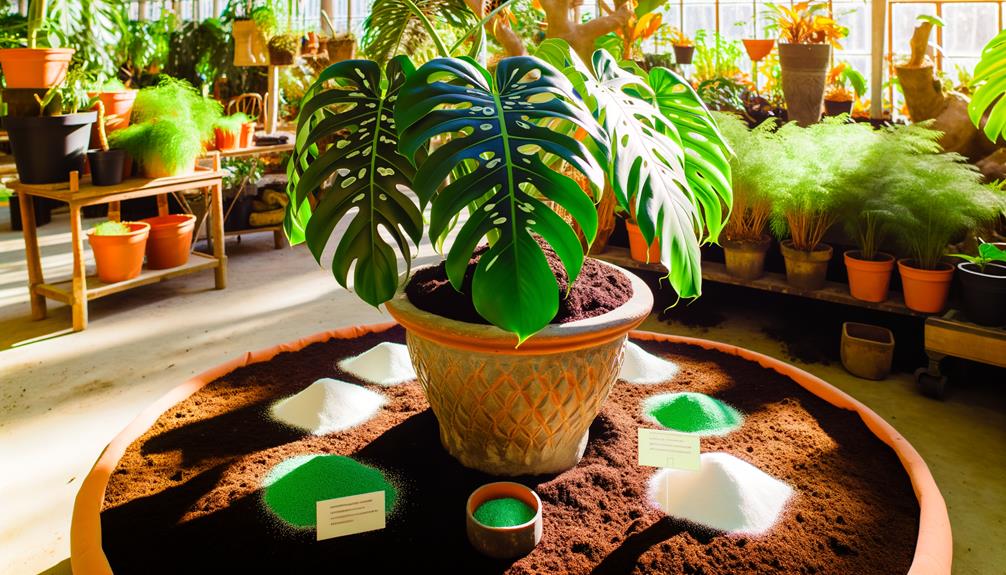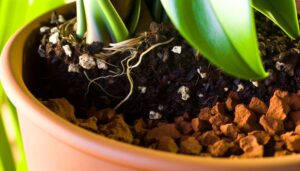Monstera Deliciosa Albo Variegata Nz
You're captivated by Monstera Deliciosa Albo Variegata, an exquisite plant with stunning variegation caused by a rare genetic mutation. Originating from Central and South American tropical rainforests, it thrives in well-drained, peat-rich soil and requires bright, indirect light.
Maintain humidity around 60-80% and water when the soil's top inch feels dry. Watch for pests like spider mites and mitigate root rot with proper watering.
In New Zealand, you can find this rare beauty in specialized nurseries or online platforms like Trade Me. Local plant groups can offer exchange tips and more in-depth advice.

Key Takeaways
- Explore specialized nurseries in New Zealand for Monstera Deliciosa Albo Variegata.
- Check online marketplaces like Trade Me for rare plant listings.
- Verify seller reputation and review detailed photos before purchasing online.
- Join local plant enthusiast groups for trading opportunities and care tips.
- Ensure proper growing conditions to maintain variegation and plant health.
Origin and History

The Monstera Deliciosa Albo Variegata, a sought-after variegated variant of the Monstera genus, originated in the tropical rainforests of Central and South America. You'll find these plants flourishing in the humid understory, where they climb trees using their aerial roots. They belong to the Araceae family, thriving in moist, well-drained soil.
Known for their fenestrated leaves, these plants adapt to low light, using phototropism to maximize sunlight capture. Historically, indigenous communities utilized Monstera for medicinal purposes. During the 20th century, the Albo Variegata gained popularity among horticulturists and indoor plant enthusiasts for its unique appearance.
The plant's journey from rainforests to homes showcases humankind's fascination with the botanical world.
Unique Variegation
Known for its striking white and green foliage, the Monstera Deliciosa Albo Variegata displays unique variegation due to a rare genetic mutation affecting chlorophyll distribution. This mutation creates patches of chlorophyll-free, white tissue alongside the green, photosynthetically active areas.
You'll notice that the variegation appears in irregular patterns, such as marbling, sectorial, or speckled forms, contributing to each leaf's distinct appearance. The absence of chlorophyll in these sections results in reduced photosynthetic efficiency, making the plant more delicate and slower growing.
Providing consistent care is crucial to maintain its health. The variegation isn't stable, meaning new growth can revert to solid green, so propagating from variegated specimens secures the preservation of this coveted trait.
Ideal Growing Conditions

To maximize your Monstera Deliciosa Albo Variegata's thriving conditions, it is essential to provide it with bright, indirect light. This helps prevent leaf burn and promotes peak photosynthesis in its variegated leaves. Position the plant near an east or west-facing window where it can receive filtered sunlight. Avoid direct sunlight, as it can cause photodamage, leading to brown scorch marks on the foliage.
Maintain a temperature range of 18-27°C (65-80°F) to ensure the plant's best growth. Using a well-draining, airy soil mix that contains peat, perlite, and orchid bark is crucial to support root health and prevent waterlogging. Ensure that the pot has adequate drainage holes to facilitate the escape of excess water.
Providing a sturdy moss pole or trellis will support the Monstera Deliciosa Albo Variegata's natural climbing habit, encouraging robust and healthy growth.
Watering and Humidity
To maximize the growth of your Monstera Deliciosa Albo Variegata, you must establish an ideal watering routine, balancing soil moisture without waterlogging.
Monitor humidity levels, aiming for around 60-80%, to replicate its tropical habitat. Use a hygrometer to maintain these conditions, preventing leaf browning and promoting vigorous growth.
Optimal Watering Routine
Achieving the best watering routine for Monstera Deliciosa Albo Variegata involves understanding its preference for consistently moist but well-draining soil and maintaining high humidity levels around 60-80%.
You should water when the top 2-3 inches of soil feel dry to the touch. Employ a soil mix rich in organic matter—like peat moss, perlite, and orchid bark—to guarantee proper aeration and drainage. Avoid waterlogging, which can lead to root rot. Use room temperature, filtered water to prevent chemical build-up.
Opt for a deep watering method, allowing excess water to drain out fully. This practice helps maintain soil moisture uniformly, mimicking its natural tropical habitat. Regularly check soil moisture levels with a hygrometer for precision.
Maintaining Ideal Humidity
Maintaining the perfect humidity for Monstera Deliciosa Albo Variegata involves keeping the surrounding air at 60-80% humidity, which mimics its natural tropical environment and promotes growth.
Invest in a hygrometer to monitor humidity levels accurately. Use a humidifier to maintain consistent humidity; place it near the plant, but not directly on the foliage to prevent fungal issues.
Misting the leaves can help temporarily, but it's not a substitute for a humidifier. Grouping plants together can also naturally increase humidity.
Avoid placing your Monstera near heating vents or air conditioners, as they can drastically reduce humidity levels. Ensuring proper ventilation will prevent mold, while pebble trays beneath the pot can provide localized humidity without waterlogging the roots.
Soil and Fertilizer

When caring for your Monstera Deliciosa Albo Variegata, you'll need well-draining soil rich in organic matter to promote healthy root growth. Aim for a mix that contains peat moss, perlite, and orchid bark to guarantee adequate aeration and moisture retention.
For fertilization, use a balanced, water-soluble fertilizer high in nitrogen during the growing season to support the plant's variegated foliage.
Ideal Soil Composition
Ensuring a thriving Monstera Deliciosa Albo Variegata requires a well-draining soil mix composed of peat, perlite, and pine bark. Peat moss retains moisture while providing organic matter, essential for root development.
Perlite enhances aeration and drainage, preventing root rot by ensuring excess water escapes efficiently. Pine bark adds structure and organic nutrients, promoting healthy root growth and microbial activity.
Aim for a soil pH between 5.5 and 7.0 to optimize nutrient availability. You should avoid heavy, compacted soils, as they restrict root aeration and water movement.
Regularly check soil moisture levels; it should be moist but not waterlogged. By maintaining this ideal soil composition, you'll support your Monstera's growth and variegation.
Optimal Fertilizer Types
To nourish your Monstera Deliciosa Albo Variegata most effectively, use a balanced, water-soluble fertilizer with an N-P-K ratio of 20-20-20 during the growing season. This guarantees an even distribution of nitrogen for foliage growth, phosphorus for root development, and potassium for overall plant health. Apply the fertilizer bi-weekly, diluting it to half-strength to prevent nutrient burn.
For soil, make sure it's well-draining and aerated, combining peat moss, perlite, and pine bark. This mix retains moisture while allowing excess water to drain, preventing root rot. Regularly monitor the pH, ensuring it remains mildly acidic to neutral (5.5-7.0).
Pruning and Propagation
Pruning and propagating your Monstera Deliciosa Albo Variegata involves precise cutting techniques and understanding the plant's growth nodes to guarantee successful growth and variegation. Start by identifying a healthy stem with at least one node and aerial root. Use sterilized scissors to make a clean cut just below the node. Place the cutting in water or moist sphagnum moss to encourage root development. Monitor light, humidity, and temperature to ensure ideal conditions.
Here's a quick reference table:
| Step | Action | Details |
|---|---|---|
| 1 | Identify Stem | Look for a healthy stem with a node and aerial root |
| 2 | Sterilize Scissors | Use rubbing alcohol to prevent infections |
| 3 | Make Cut | Cut just below the node |
| 4 | Place in Medium | Use water or moist sphagnum moss |
| 5 | Monitor Environment | Maintain proper light, humidity, and temperature |
Proper technique will maximize your plant's success.
Common Pests and Diseases

Dealing with common pests and diseases in your Monstera Deliciosa Albo Variegata requires a keen eye for symptoms and swift action to prevent damage. Spider mites, aphids, and scale insects often target this plant. You'll notice webbing, sticky residue, or small, brown bumps on the leaves.
Fungal infections like root rot occur due to overwatering and poor drainage. Yellowing leaves and mushy roots are clear indicators. Bacterial leaf spot presents as water-soaked lesions on foliage.
Use insecticidal soap or neem oil for pest control, and ensure proper watering and airflow to prevent fungal issues. Regularly inspect your plant for early signs of trouble, and isolate affected plants to halt the spread of pathogens and pests.
Where to Buy in NZ
Locating a Monstera Deliciosa Albo Variegata in New Zealand involves exploring specialized nurseries, online marketplaces, and plant enthusiast groups that offer rare and variegated specimens.
Here's a detailed approach to find your desired plant:
- Specialized Nurseries: Visit nurseries that focus on rare and exotic plants. They often have a more diverse selection and knowledgeable staff to guide you.
- Online Marketplaces: Websites like Trade Me and specific plant e-commerce sites list Monstera Deliciosa Albo Variegata. Make sure the seller has good reviews and provides detailed photos.
- Plant Enthusiast Groups: Join local plant groups on social media platforms. Members frequently trade or sell rare plants and share valuable care tips.
Conclusion
Caring for a Monstera deliciosa albo variegata in New Zealand can be as fulfilling as finding treasure. With the correct balance of light, water, and nutrients, your plant will flourish, displaying its striking variegation.
Consistent pruning and attentive pest control guarantee it stays in good health. By comprehending its distinct requirements, you're not just nurturing a plant; you're nurturing a work of art.
So, immerse yourself and allow your Monstera to be the centerpiece of your indoor garden.






